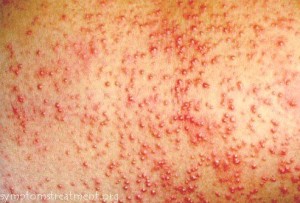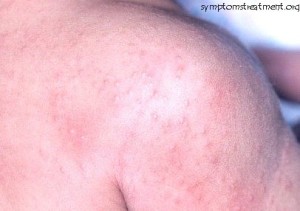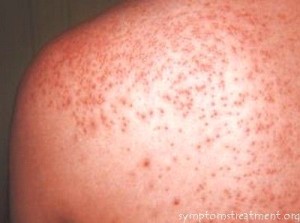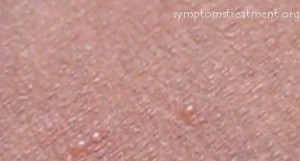Prickly heat rash refers to a skin condition which results in the development of blisters or lumps. Such blisters can be itchy and cause prickly sensations. The condition is more common among infants and children. However, adults are equally vulnerable to the skin condition, especially during hot and humid weather. Prickly heat rash is also known by another name, i.e. Miliaria.
When the sweat ducts become clogged, it leads to the trapping of perspiration under the surface of the skin. This may eventually result in the development of prickly heat rash, followed by the formation of superficial blisters or reddish, deep lumps.
In most cases, prickly heat rash disappears on its own. The affected individuals need to prevent excessive collection of sweat and lower the temperature of the body and skin to effectively resolve the condition. However, extreme incidences of the condition may require drug treatment.
Symptoms of prickly heat rash
Adults are generally affected by prickly heat rash in areas such the skin creases and also where the skin may brush against clothing leading to friction. Prickly heat rash tends to affect the chest, neck and shoulders in most infants. In other cases, the condition may also affect other regions of the body such as the elbow folds, the groin and even the armpits.
There are three types of prickly heat rash and each type has its typical symptoms. Listed below are the various types of prickly heat rash and their respective symptoms:
Miliaria crystalline
- This form of prickly heat rash is the mildest of the lot and tends to affect the sweat glands or ducts that are present in the topmost layer of the skin.
- It results in the formation of clear, tiny and shallow blisters. Sometimes, it may also cause small bumps or papules that burst easily
- There is no itching or pain from the blisters and they tend to disappear on their own. However, the probability of the condition relapsing are great in hot and humid conditions. Newborns are more vulnerable to develop this form of prickly heat rash than adults
Miliaria rubra
- It usually occurs deeper within the skin and tends to affect sweat glands that are present in the outer layer of the skin or the epidermis. Adults who have been exposed to hot and humid weather conditions for prolonged periods or hospitalization that requires bed rest for longer durations can get affected by this condition. Infants who are in between their first and third weeks after birth can get affected by it as well.
- The affected regions may have intense itching as well as prickly sensations
- There may the development of red bumps
- The affected regions may not perspire or show diminished sweating.
Miliaria profunda
- Adults who have had chronic cases of miliaria rubra generally tend to get affected by this rare form of prickly heat rash. It occurs much deeper within the skin and tends to affect the dermis. Activities that precipitate perspiration such as strenuous and heavy physical exercise may eventually lead to the development of this form of prickly heat rash.
- The skin condition is accompanied by the development of lesions that look like goose bumps and are flesh-colored and solid
- Decreased or diminished sweating can result in several symptoms of heat exhaustion such as hypertension, nausea, racy heartbeats, dizziness and headaches.
There can be some complications that may arise from prickly heat rash, which are listed below:
- Infection of prickly heat rash by bacteria and other germs may result in inflammation of the bumps. Some of the signs of infection include oozing of pus from the lesions or bumps, chills and fever, and inflammation of lymph nodes in the armpits, the neck or the groin. Additionally, there may be increased redness and pain, swelling or warmth of the affected areas.
- Untreated cases of heat exhaustion that result from prickly heat rash may eventually lead to the development of a heatstroke
Causes of prickly heat rash
The blockage of the perspiration ducts causes the formation of prickly heat rash. Such clogged ducts prevent the sweat from evaporating and thus they become trapped beneath the skin leading to rash and inflammation of the skin.
Some of the reasons that lead to clogging of the sweat ducts are discussed below:
- The sweat ducts in newborns are not developed completely and hence they are vulnerable to easy rupture. This may eventually lead to sweat being trapped under the skin. Infants who are placed in incubators or wrapped in heavy woolens; have high fever or when they are exposed to hot and humid weather can be probable causes of immature infant sweat duct rupture.
- Heavy exercise or extreme physical activities can lead to increased sweating. This may cause blockage of the sweat glands leading to prickly heat rash development
- Increased use of ointments or skin creams that lead to blocking of the skin pores
- Hot and humid conditions or tropical climates
- The use of certain fabrics or tight clothing that prevents the evaporation of sweat
- The use of increased number of warm blankets or the use of an electric heater during winters can lead to the development of prickly heat rash
- Some types of drugs used to cure illnesses can result in the skin condition
- In rare cases, hospitalization that requires prolonged bed rest for patients
Treatment of prickly heat rash
- The limitation of physical exercise, loose clothing and staying indoors in air-conditioned environment can cool the body and prevent excessive sweating. This is one the best ways to treat prickly heat rash
- Moderate cases of prickly heat rash can be treated with topical medication to ease the itching as well as prevent duct blockage
- The severest cases of prickly heat rash can be treated with topical steroids
Prickly heat rash pictures
Here are prickly heat rash photos, check out how the skin is impacted and rash formed due to exposure to sun.




فروشگاه تم تولد لبخند تولید کننده انواع تم تولد پسرانه و دخترانه، تنوع محصول بیش از 72 مدل تمجهت خرید وارد سایت شوید، فروشگاه لبخند داره نماد اعتماد می باشد.